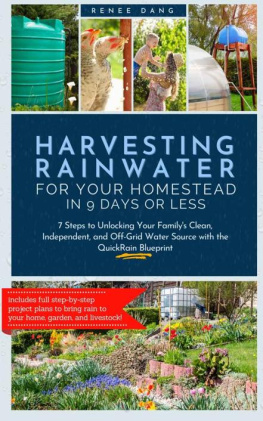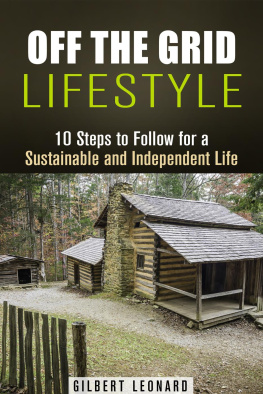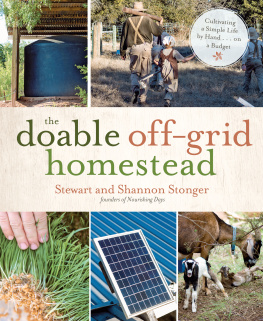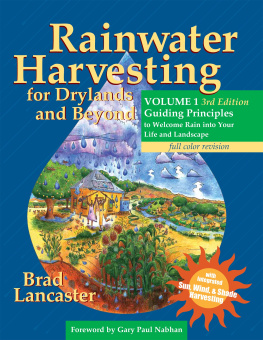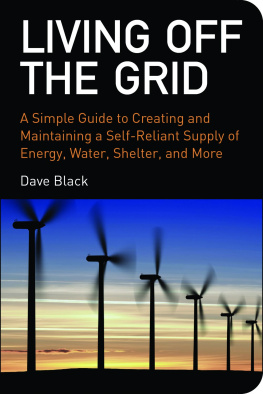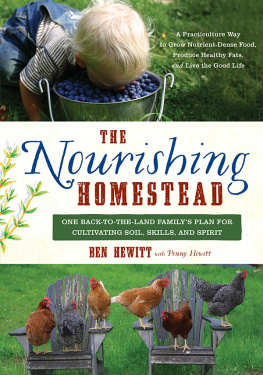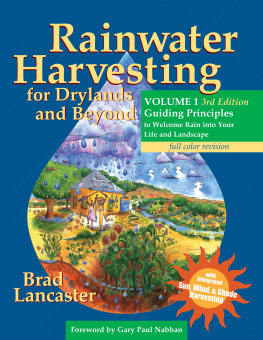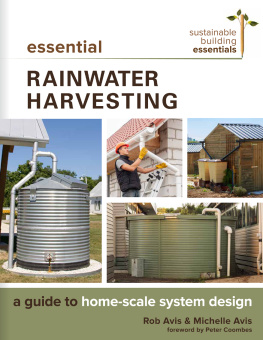Introduction
H ave you suddenly realized that your homestead is having trouble with its water source? Are you finding that a well is extremely expensive to dig where you live or that you have no groundwater? Maybe youve just always wondered how you could collect and use the free rain falling from the sky as a resource for you and your family. This book will show you how to harvest rain and start using it for all of your needs quickly, easily, and without breaking the bank.
Harvesting rainwater offers many advantages. In recent years (especially with greater water shortages and tougher droughts), families and farmers have been turning back to the worlds primary source of fresh waterrainwhen they realized that their groundwater and rivers were drying up. Laws and legislation in the US against rainwater harvesting are quickly changing to incentivize rather than discourage harvesting rain. The City of Philadelphia will pay up to $100,000 per acre of rainwater captured! Perhaps your local state or municipality is also accommodating the increasing demand for legal rainwater harvesting.
You may also be incentivized to collect rainwater due to limited or poor groundwater resources. Many families in the US want to have a backup source of water if their well runs dry. You may share a well with other families, but you may also be looking for greater control of your water sourcewhile everyone can do their best to follow the rules and not contaminate a well, it just takes a few mistakes to spoil the well for an entire water table. But if you collect rain in tanks that only your family manages, you will once again find the peace of mind that comes with having an independent water source.
Rainwater is a distilled, nutrient-filled, anddepending on where you liverather abundant resource. (It should be noted that many desert homesteaders in the southwestern United States collect rainwater year-round as their primary source of water. And they live in a place generally considered to be extremely arid! Does your location receive more rain than a desert?) If properly treated, rainwater can be used for drinking and cooking, and it can also be used for gardening. Rainwater itself is no more acidic than coffee, and its slight acidity and high oxygen and nitrogen content create very green, healthy, strong plants. Whether theyre indoor or outdoor, you can help your plants fight disease, yield more fruit, and grow stronger root systems by watering them with rainwater. Watering livestock such as chickens or goats with rainwater is another great way to use rain.
This book will take a beginner with zero knowledge of rainwater harvesting to feeling confident in sourcing, installing, and maintaining the right rainwater harvesting system for their garden or homestead in 9 days or less. The primary focus of this book will be on using tank systems to collect rainwater for later use.
The Simple Truth About Harvesting Rainwater
Rainwater harvesting is simple: collect the rain, store the rain, and use the rain. Harvesting can be optimized by taking into account the topography of your location, how much space you have, which type of pump to get, which materials will optimize rain catchment efficiencythe list goes on. Having so many options can make harvesting seem like an endless and daunting task. However, most rainwater harvesters follow the same basic principles, plans, and system requirements to meet their needs. This book distills all of the considerations that pertain to safety, installation, and maintenance into a handful of guiding principles to get you collecting rain right away.
While your specific topography or climate may require slight changes in the size or shape of your system (as well as careful winterization or frost protection considerations for cold climates), the methods described in this book can be adapted by most rainwater harvesters. Collectively, these methods are called the QuickRain Blueprint.
The QuickRain Blueprint uses the most common, the most recommended, and the easiest-to-maintain type of system and scales it to meet your familys water needs. This is a dry system, and it routes rain from the roof to the gutters and then straight into a tank. Theres no need to bury pipes or tanks. Its the quickest system to set up and maintain, which is exactly whats most beneficial to those needing a reliable water sourcefast.
A dry system basically works as an enlarged rain barrel. It works beautifully for most people, most homes, and most properties. It may work beautifully for you and your family as well. This method simplifies rainwater harvesting: theres no need to bury pipes, no need to worry about pipes bursting in the winter, and no need to worry about inspecting an underground tank. The QuickRain Blueprint uses the roof and gutters you already have, and it guides you through selecting, scaling, and sourcing your materials to installing and maintaining your system so that you can feel confident in your water quality. The QuickRain Blueprint can be adapted for chicken coops, sheds, or any other roofed structure on your property. The math is already be done for you! You just need to choose the size of the tank(s) you need depending on your water needs, your budget, and how much space you have. Because of how quick and easy the QuickRain Blueprint is, the systems in this book can be chosen and installed in as quickly as 9 days or less (not accounting for variable delivery or fulfillment times for parts or materials).

